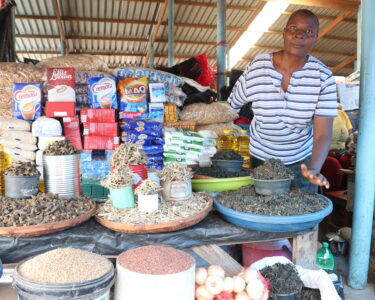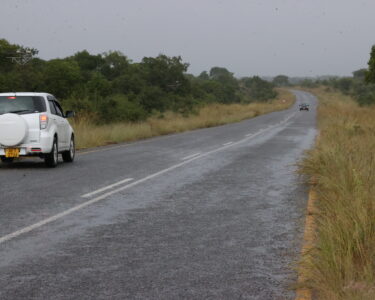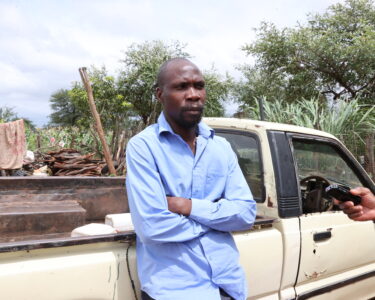… Devolution has had a very big impact here’, says Minister of State
Hon Ezra Chadzamira is the Minister of State for Provincial Affairs and Devolution for Masvingo Province. On 14 February 2023, he sat down with a visiting team of Brick by Brick editors to talk about his province. “We are now one of the best provinces in the country,” he told them. “We have completed more than 170 projects, including schools and health facilities. All this has been done under devolution, from 2018 to date. Devolution has had a very big impact in this province.”
Hon Chadzamira was also happy about the rehabilitated Harare-Masvingo-Beitbridge road. “We have experienced a big reduction in accidents because of the expansion of the road. If you look at the statistics of the past and the current, we are a happy province now. We no longer have the road accidents of the past.” Who says people don’t eat roads!! Our managing editor, Baffour Ankomah, led the interview with Minister Chadzamira.
Q: Minister, thank you for welcoming us to your office. Can you briefly tell us about Masvingo Province?
A: Masvingo Province is one of the best provinces in the country. In fact, it is Zimbabwe’s best province. First, it is strategically and centrally located. As such the other provinces are equidistant from Masvingo city. If you want to go to Mutare from Masvingo, it is the same distance to go to Harare. It is the same distance to go to Beitbridge and it is the same distance to go to Bulawayo. It means wherever you want to do business, you can choose Masvingo because it is convenient to do business from here.
This province borders with Manicaland, Matabeleland South, Midlands, and Mashonaland East. Internationally, it shares borders with Mozambique and South Africa. Our population is about 2 million.
As a province, we are very grateful for the climate we have here. We have the best climate among the provinces of the country. As such, you can grow maize here even in June because of the temperatures we have in the southern parts of the province.
We have 7 districts, which are Masvingo, Gutu, Bikita, Zaka, Chiredzi, Chivi and Mwenezi. We are in the ecological region 4 and 5. It is an area with low rainfall, but we are fortunate to have 54% of the nation’s dam waters because of the number of dams we have in the province, which is a huge advantage for us.
Q: You mean Masvingo Province has 54% of the water in all the dams in the country?
A: Yes, 54% of the water in all the dams in the country is found in our province.
We have the largest inland dams in the country, which are Tugwi Mukosi (number one) and Mutirikwi Dam (number two). We also have the Manjirenji Dam, Siya Dam, Mushandike Dam, Manyuchi Dam and severeal others. And the biggest of them all is coming soon – the Runde-Tende Dam to be built at the confluence of the Runde and Tende rivers in southern Chivi.
So Masvingo is a blessed province. We have resources that can contribute immensely to the achievement of Vision 2030, the national vision of an upper middle-income economy by the year 2030.
Additionally, the province is a proud beneficiary of all the government’s development plans – the Transitional Stabilisation Programme (2018-2020), the 2021-2025 National Development Strategy 1 (NDS1), and we will benefit even more as we move towards NDS2.
Q: How much is Masvingo contributing to the National GDP?
A: The national GDP, I understand, is over US$28 billion and Masvingo contributes about 11%, which is over US$3 billion. But to help the country to achieve the national Vision 2030, we need to up our game in the province. You know the country is targeting mostly mining, tourism and agriculture as the most important sectors that will contribute to the achievement of the national vision.
As a province, Masvingo is focusing on the same critical sectors as the government – mining, tourism, and agriculture. We are big players in these sectors.
Q: What are some of the economic activities that make the province tick?
A: We are strong on mining. Currently we have many minerals, including lithium, diamonds, asbestos, gold, copper, manganese, chrome and steel. We have new investments at Bikita Minerals, an expansion of about US$300 million, divided into Phase 1 and Phase 2, to add value to lithium. The project has already started.
We also have Simbi Steelmakers in Masvingo, another expansion programme that will bring employment to more than 2,000 people directly, and about 7,000 to 8,000 people indirectly
The New Dispensation has also brought about a chrome smelting plant, the Zimbabwe Zhongxin Smelting Company at Mashava, a new investment of over US$60 million that is already 99% complete. They are waiting for the President to come to officially commission it.
We are also looking to the resuscitation of the asbestos mine at Mashava so that it can contribute again to the national economy. Long back, the Mashava mine contributed about 10% of the national GDP when it was operating at full capacity. It is one of the giant companies that, if resuscitated, will hugely benefit the province and the nation.
We are also going to have a diamond mine at Murewa. It is part of the Murewa expansion. I think exploration is over. They are now starting their processes to construct their facilities, which means they are looking into how to relocate the people of the area and also some parts of Masvingo here.
This expansion is coming thanks to the leadership of the New Dispensation. It shows that the President is doing a great job. He has been in power for a short period, but within this short period we have seen massive development in the Masvingo Province.
In tourism, we are going to have a facelift of the Great Zimbabwe Monument, the outside appearance. There has been an injection of US$3.5 million into the project. It is another milestone which will increase the tourist numbers coming to Masvingo.
We also have the Gonarezhou National Park and the Tugwi Mukosi Dam. We are in fact waiting for the master plan of Tugwi Mukosi to come out soon. If it does, there will be many opportunities – holiday homes, water sport, even they are going to create a national park around Tugwi Mukosi. It means Masvingo will never be the same again as the nation moves towards the achievement of Vision 2030. The tourism part will contribute immensely to the vision.
Q: When exactly do you expect the Tugwi Mukosi master plan to come out?
A: On our part as a province, we have finished the draft. We have sent it to the national government and it is awaiting cabinet approval so that we can start activities around it.
On agriculture, a most important area, we are targeting about 300,000 hectares to be put under irrigation because of the water bodies we have in the province. Currently, the projects underway are: At Buffalo Range we have about 8,000 hectares under development. At Kilimanjaro, we have about 4,000 hectares (it is a sugar plantation), and another 13,000 hectares at Chiredzi to grow Lucerne as livestock feed.
If we manage to reach the 300,000-hectare target under irrigation, we will have achieved our aim of becoming the breadbasket of the nation, because we have water that should put us on the safe side of climate change.
Here, I want to thank President Mnangagwa. You know as a nation, we have many challenges like other nations, but the President did not become just a cry baby, sitting down and saying, “we have economic challenges because of sanctions, we have climate change, we have disasters, so we just beg for assistance”. No, he said “let’s use the resources we have”. Because of that, see where we now are. We have made progress much faster as a nation towards the development of our economy.
Last winter season, this province managed to grow 2,400 hectares of wheat in the southern region, against our target of 2,000 hectares. It means we are doing well. Agriculture 8.0 is also doing well in the province. We are drilling boreholes in every village so that the people can have gardens around the boreholes. Under Agriculture 8.0, the President is contributing poultry, heifers, and a Presidential Borehole Drilling Scheme. We are taking full advantage of this programme so that we can contribute meaningfully to the GDP of our country.
Q: How much investment has the province received under the Second Republic and which areas are investors interested in?
A: I have already touched on the areas we have benefitted from under the New Dispensation government. I have talked about mining – the Bikita Minerals expansion, the Simbi Steelmakers expansion, the Zimbabwe Zhoungxin smelting plant in Mashava, the Amarula processing plant in Mwenezi District, the Murewa Diamonds expansion and exploration, and the other mining ventures.
On agriculture, we have the Lucerne project in Chiredzi where we are doing 13,000 hectares currently, there is the 4,000 hectares sugar cane plantation in Chiredzi again, and also the 8,000 hectares in Buffalo Range – all those are new investments.
Q: You have mentioned the benefits that the province has enjoyed under the Second Republic. But tell us, what has the rehabilitation and widening of the Harare-Masvingo-Beitbridge Road brought to the province?
A: Road infrastructure is another area that we have benefited. The Beitbridge-Chirundu Road rehabilitation and widening programme has immensely benefitted the Masvingo Province. The increase in motor traffic means increased employment opportunities for our people. The new road has provided quick access to other provinces and countries. It is a very good initiative, which has even added to the beauty of our province.
The other roads in the province, whether you want to go to Shishavane or Chivi or Mutare or Beitbridge or Harare – all are now good roads.
Again, as a province, we have also benefited immensely from the government’s devolution programme, such that the roads under our rural councils and even in the urban centres are now good roads. This is because of devolution funds, which we have used to upgrade our roads, built health facilities, schools, boreholes, market stalls, etc.
We are now one of the best provinces in the country. We have completed more than 170 projects, including schools and health facilities. All this has been done under devolution, from 2018 to date. Devolution has had a very big impact in this province.
Q: Still talking about the new Harare-Masvingo-Beitbridge road, has it reduced motor accidents?
A: Yes, we have experienced a big reduction in accidents because of the expansion of the road. If you look at the statistics of the past and the current, we are a happy province now. We no longer have the road accidents of the past.
Q: Amidst all the good news, there must be some challenges facing the province. What are some of these challenges and how are you resolving them?
A: Like any other province, we have both natural and artificial challenges. Some of the artificial challenges include economic sanctions. We have also had natural disasters like Cyclone Idai, the Covid-19 pandemic and others, but because of what the President is doing – the engagement and re-engagement policy – we have managed to overcome the Covid-19 pandemic and also helped those who suffered from other disasters.
Currently, we have the challenge of the Tugwi Mukosi master plan which is yet to come out. We know that if it comes out, our province will be able to contribute more to the national 2030 vision even before we reach the year 2030, because we already have the resources.
Q: So what is holding back the master plan? Is it just bureaucracy?
A: I think it is bureaucracy. We built the dam before doing the master plan. It is the opposite of what we should have done. We constructed the dam without solidifying the vision. It should have been the other way around – we do the master plan first before building the dam. We have learnt our lessons which won’t be repeated in the future. We must have a master plan first, before building any dam, so that as soon as the dam is completed, we make use of the master plan.
As we are looking at tourism, there are plenty of opportunities around Tugwi Mukosi – holiday homes, hotels, and even the dam can generate 17 MW of hydro power. It means all these opportunities have been delayed because the master plan has taken too long to come out. Currently we are only using the dam for agricultural purposes, and not for anything else.
We are now looking into other programmes for generating electricity. We have already started a generation project at the Mutirikwi Dam, to give us about 5.8 MW.
Q: As a province, what plans are there for the future?
A: We have on the cards the Runde-Tende Dam, the feasibility studies have been completed, and the South African company that won the bid is already on the ground. This dam is going to supply water even to South Africa and Matabeleland South Province.
Masvingo Province will use 50% of the dam waters, while the other 50% goes to South Africa and Matabeleland South Province. Along the way, many people in the Mwenezi District and Matabeleland South will benefit because the water will go to South Africa via a canal.
Elsewhere, we are looking at the resuscitation of the Mashava asbestos mine. As I said earlier, this mine was contributing 10% to the national GDP in the past, so we want it to be resuscitated.
Also, we have more than one million cattle in the province. In terms of livestock farming, I think we are second only to Bulawayo or Matabeleland North Province. So we want to resuscitate the Cold Storage Commission in Masvingo so that we add value to our cattle before sale.
We are also looking at adding another sugar and ethanol plant to the one we already have in the province. So these are the big projects we are looking at, going forward.
Q: You talked about the resuscitation of the Mashava mine. What led to the current situation?
A: The current situation came about because of an ownership rankle between the private investor and the government that led to the closure of the mine. The government then took over and put it under administration.
Since then, about 20 million Zim dollars have been invested in a de-watering project at the mine, which is about to finish so operations can re-start. Currently, the government is in charge of the resuscitation programme and is looking for new investors to come in.
Now, as a nation, we are importing asbestos from Brazil and Canada, but we have a big asbestos mine at Mashava. It doesn’t make sense. That’s why we are pushing for the mine to be resuscitated.
Q: You recently took your office staff to a retreat in Mutare to talk about your plans to develop and improve life in the Masvingo Province Any exciting news from the retreat?
A: Yes, we went to do our Strategic Planning Workshop to look at the 2023-2025 period, but the emphasis was on 2023. The aim was to align our strategic plans and targets with NDS1 so that the province can contribute meaningfully to the achievement of Vision 2030.
So, it was about brainstorming. We asked the relevant officers in charge of our internal departments to come up with their plans. We scrutinised the plans to see what would be funded by the government in the 2023 budget. As the provincial office, our responsibility now is to coordinate those activities and provide an oversight role to ensure that NDS1 and Vision 2030 come to fruition.
Q: Lastly, Minister, you can’t talk about Masvingo Province without mentioning “masibanda”. Please explain to a tourist or a foreigner like me what is “masibanda” in the constellation of the Masvingo people?
A: [Laughs heartily]. If you marry a masibanda, you have married a good wife. You are going to be rich. You are going to be a decent man. An intelligent, smart man. That is the masibanda type of man. It is a strength of Masvingo Province. The current President is also a masibanda.









